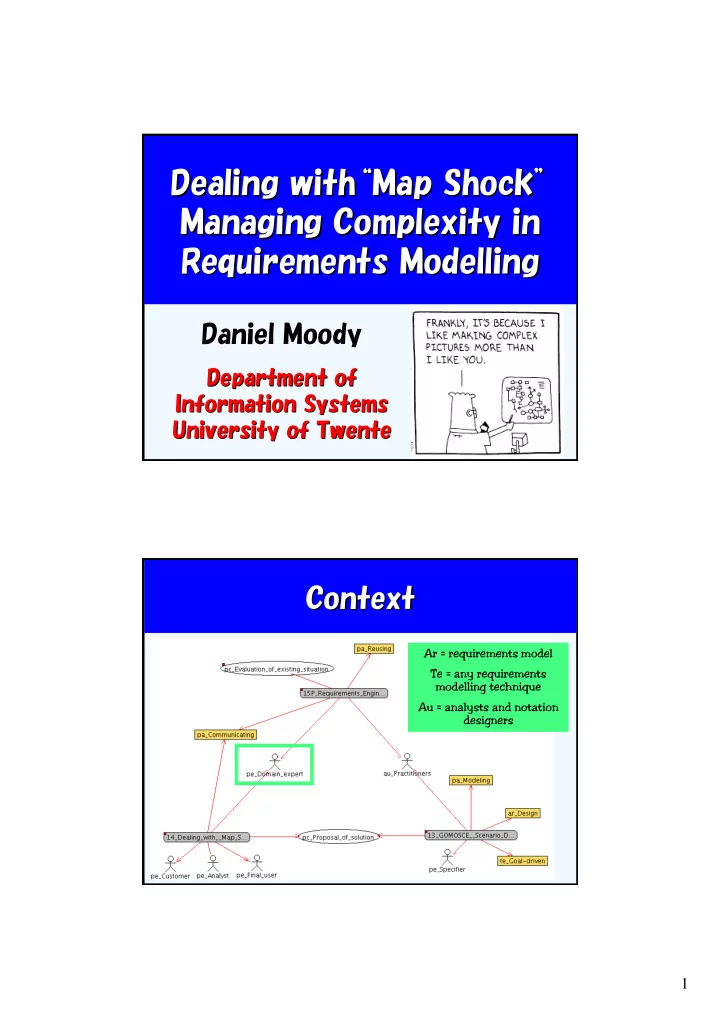

Dealing with with“ “Map Map Shock Shock” ” Dealing Managing Complexity in Managing Complexity in Requirements Modelling Modelling Requirements Daniel Moody Daniel Moody Department of Department of Information Systems Information Systems University of Twente Twente University of Context Context Ar = requirements model Te = any requirements modelling technique Au = analysts and notation designers 1
Research Question Research Question Why Complexity is Such a Problem Why Complexity is Such a Problem in Requirements Engineering in Requirements Engineering 1. The complexity of the underlying systems being modelled � Dijkstra: the complexity of modern software presents an intellectual challenge that has no precedent in human history 2. Lack of complexity management mechanisms in most RE notations 3. Models used to communicate with people who are not technical experts 2
“Map Shock Map Shock” ” “ Amount of information that can be effectively conveyed by a single diagram limited by human perceptual and cognitive abilities: � Perception: ability to discriminate between diagram elements reduces with their number and proximity ( ≈ 20 elements on A4 paper) � Cognition: number of diagram elements that can be comprehended at a time limited by working memory capacity ( ≈ 7 ± 2 elements) Research Method Research Method Solve problem for particular modelling technique (ER modelling) and generalise Initial Method 8 action Method Field Testing research refinement (Action Research) studies Revised Method Laboratory Laboratory Field Experiment: Experiment 1: Experiment 2: Adoption in End User Documentation and Practice Understanding (O ) Maintenance (O ) 1 2 3
Research Method Research Method Solve problem for particular modelling technique and generalise General Learning Problem-Specific Learning Principles Objectives Method Outcomes Single Loop Learning (HOW) Double Loop Learning (WHAT) Triple Loop Learning (WHY) Research Results Research Results Decomposition Perceptual Graphic Summarisation Complexity Grouping Spatial Identification Redundancy Contiguity Complexity Management Contextualisation Signposting Navigational Indexing Map 4
Principle 1: Decomposition Principle 1: Decomposition Divide large diagrams into cognitively and perceptually manageable chunks Sub-Diagram n Sub-Diagram 1 Sub-Diagram 2 Sub-Diagram 1 Single interconnected Set of manageable sized diagram sub-diagrams The Magical Number, Seven, The Magical Number, Seven, Plus or Minus Two Plus or Minus Two 5
Divide Large Diagrams into Divide Large Diagrams into Manageable Sized Chunks Manageable Sized Chunks 7 ± 2 elements Credit Customer Customer Terms Contact No Segment per diagram belongs to has has Customer made by has Customer Payment consists of Contract Person located has in Customer Contract Sales Region Organisation Address Item from Product Supplier Availability manages placed by responsible delivery applies to has for address sent to results in is part of consists of relates to takes Purchase Purchase Employee Order Order Item Product has Item Order has relates to placed by has contained Payment matched to consists of in Product Product Apportion Invoice Invoice Item Warehouse Price Stock ment Principle 2: Summarisation Principle 2: Summarisation “Big picture” view: provides overall map into which Summary Diagram information from different diagrams can be integrated summarise (possibly recursively) ... Detailed Diagrams 6
Principle 8: Spatial Contiguity Principle 8: Spatial Contiguity Allow multiple diagrams to appear simultaneously within the visual field ... ... Principle 9: Principle 9: Perceptual Grouping Perceptual Grouping Use Gestalt principles to group elements together into manageable sized chunks � Both an alternative to and complementary to decomposition Unstructured Diagram Diagram organised into perceptual groups 7
Summary Summary Quality features: understandability � completeness, accuracy Contribution: definition of 9 principles for incorporating complexity management into diagrams and/or notations How will this improve practice/research: � Help RE practitioners communicate complex models to end users � Help notation designers incorporate complexity management into RE notations Main problems: needs to be tested on other types of models Scaling up: based on a real world solution Interdisciplinary Interdisciplinary Generalisation Generalisation Requirements models an instance of a more general class of diagrams Node-link called node-link diagrams: diagrams � Used in a wide range of disciplines: business, Requirements education, communications, models engineering, psychology Potential applications of the research beyond the IS field ER models 8
Recommend
More recommend